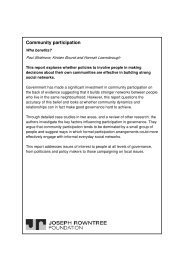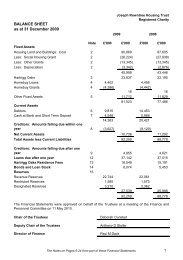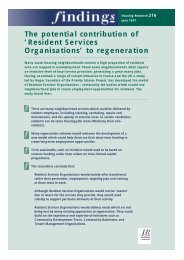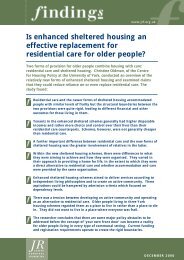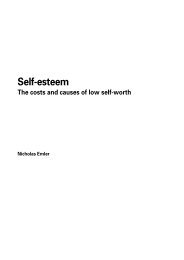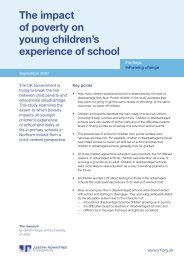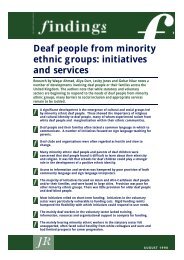Low intensity support - Joseph Rowntree Foundation
Low intensity support - Joseph Rowntree Foundation
Low intensity support - Joseph Rowntree Foundation
You also want an ePaper? Increase the reach of your titles
YUMPU automatically turns print PDFs into web optimized ePapers that Google loves.
<strong>Low</strong> <strong>intensity</strong> <strong>support</strong>: preventing dependency<br />
The Home-Link model<br />
Help for people with mental health problems in general<br />
needs housing<br />
communication and understanding has also been<br />
improved. These benefits have led to the service being<br />
expanded throughout the East Riding of Yorkshire.<br />
Home-Link is an inter-agency service based in the East<br />
Riding. It provides permanent housing and low-level,<br />
practical <strong>support</strong> to people with enduring mental<br />
health problems - including mutual <strong>support</strong> networks.<br />
The housing department allocates secure tenancies to<br />
people, usually near each other. Many properties are<br />
connected to a highly valued, 24-hour ‘lifeline’ service.<br />
People contact their workers freely between visits for<br />
advice or reassurance.<br />
Home-Link workers spend around 5 or 6 hours with<br />
each user a month, providing help with budgeting,<br />
bills and other household matters. They are<br />
deliberately not qualified as mental health<br />
professionals, to avoid a medical emphasis. Home-Link<br />
has also learnt from KeyRing and introduced mutual<br />
<strong>support</strong> networks.<br />
Clear aims and objectives are seen to have contributed<br />
to the success of the scheme:<br />
Aims<br />
Home-Link aims to provide people with enduring<br />
mental health problems with the opportunity to live in<br />
permanent, good quality housing with <strong>support</strong>. Home-<br />
Link aims to provide a service which will:<br />
• Integrate people into the community<br />
• Promote independent living and reduce isolation<br />
• Increase options in the range of <strong>support</strong>ed<br />
accommodation<br />
• Prevent a deterioration of people’s mental health<br />
condition, thereby hopefully reducing the need for<br />
admission to hospital<br />
• Deliver flexible <strong>support</strong> to people in permanent,<br />
good quality accommodation<br />
Benefits to users<br />
Over half of those interviewed had felt an<br />
improvement in their mental health since joining the<br />
scheme. Many thought the <strong>support</strong> had helped reduce<br />
their anxiety and strengthened their ability to be<br />
independent.<br />
“If I’d have had to set up on my own, I might not have<br />
managed it. I might not have made the move.”<br />
Benefits to agencies<br />
Health and social services staff feel that Home-Link helps<br />
free up professional time to concentrate on people with<br />
more severe needs. Housing staff feel there have been<br />
management benefits: no complaints have been received<br />
about any of the Home-Link users or their neighbours,<br />
and no rent arrears have built up. Inter-departmental<br />
Objectives<br />
• To develop good working partnerships between<br />
health, housing, social services and voluntary<br />
agencies, using existing organisational networks,<br />
in order to deliver integrated housing and <strong>support</strong><br />
services<br />
• To allocate or help secure good quality ordinary<br />
housing for people with mental health problems<br />
which offers security of tenure<br />
• To provide continuous <strong>support</strong> to Home-Link<br />
members, as appropriate<br />
• To provide advice and assistance to facilitate<br />
access to and take up of other resources and<br />
services<br />
• To foster the development of social links and<br />
contact with outside organisations via a Home-<br />
Link network<br />
What works best<br />
Providers seeking to learn from pilot schemes’ best<br />
practice should consider:<br />
• Drawing up key principles behind and aims and<br />
objectives for their scheme<br />
• Benchmarking schemes against those already<br />
operating, for example, KeyRing and Home-Link<br />
• Carrying out initial and ongoing cost-benefit<br />
analysis of preventive services against the costs of<br />
curative care<br />
• Designing services around the needs of users<br />
rather than professionals<br />
• Ensuring a ‘whole system’ approach influencing<br />
work practices of all relevant agencies<br />
• Adopting appropriate terms and language, for<br />
example, ‘help’ not ‘care’<br />
• Helping people to manage their relationships with<br />
members of the local community<br />
• Supporting people to minimise the risks of abuse<br />
or intimidation and helping people deal with any<br />
difficulties that do arise<br />
5



